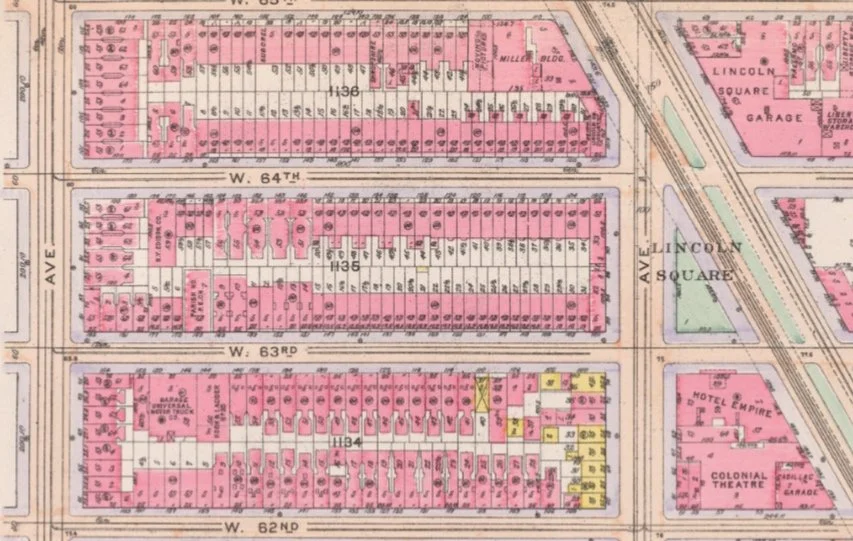Field Guide to the Ordinary Buildings of Manhattan
Taxonomy/Table of Contents
This guide’s taxonomy of Manhattan’s ordinary buildings is basically its table of contents as well. It names twenty-fivecategories of Manhattan’s fabric building types, each assigned toits proper era and period. Besides describing and discussing these types of buildings, the guide will include brief profiles of the architectural fabric of Manhattan’s neighborhoods and districts from the perspective of this classification system. The sequence of posting new chapters will generally follow the outline below, with exceptions such that Early and Late Brownstones will be treated in the same essay, as will Early and Late Loft Buildings, Prelaw and Old Law Tenements.
Sometimes the eras and periods have exact years for their beginning or conclusion, and sometimes, when the year ends in a 0 or a 5, it is an approximation. In each case where an exact year is assigned, the cause is a decisive legal building requirement that went into effect that year: 1879, 1901 and 1916are such years. The exception to this rule is caused by World War 2, which abruptly ended the Prewar Era in 1942 and did not allow the beginning of the Postwar Era until 1947. This interval was a genuine hiatus in the development of Manhattan and is treated as a near total void in its architectural history.
Sometimes the life-span of a fabric type does not exactly coincide with its assigned period. For example, a few Postwar Superblock Complexes were actually built in the Prewar Era and during the wartime hiatus, but they are expressions of a type that only became significant in the Postwar Era.
Federal Era (1795 to 1835) Early republican New York, represented today by only one of the several types of buildingsthat comprised its architectural fabric
Federal Dwellings: mostly tiny, middle-class, single-family houses, sometimes mixed-use
Victorian Era (1835 to 1901) The long era of load-bearing wall buildings, the great majority built on a single lot
Early Victorian Period (1835 to 1875) Decades of modest, restrained styles and ornamentation, relentless consistency of form
Early Brownstones (1835 to 1875): middle-class/upper middle-class single-family rowhouses
Prelaw Tenements (1835 to 1879): working-class multiple-dwellings with windowless interior rooms
Early Loft Buildings (1810 to 1875): includes all commercial, industrial, and retail buildings
Late Victorian Period (1875 to 1901) Increasing displays of wealth; increasing diversity of form and size
Late Brownstones (1875 to 1907): lower middle-class to upper middle-class single-family rowhouses; generally somewhat larger and much more flamboyant than Early Brownstones
Old Law Tenements (1879 to 1901): working-class multiple-dwellings with air shafts; generally built further into their lots and often more decorated than Prelaw Tenements
French Flats Buildings (1875 to 1901): middle-class/upper middle-class multiple-dwellings, some with passenger elevators; private lavatories within each apartment, unlike Tenements
Late Loft Buildings (1875 to 1900): commercial, industrial and retail buildings; typically larger than Early Loft Buildings, introducing steel reinforcement in the 90s
Townhouses (1885 to 1920): one-off, upper-class, single-family houses/mansions
Urban Era (1900 to 1942) Manhattan’s iconic era of explosive growth, verticality, density, with the geometric expansion of size enabled by steel frames
Premodern Period (1900 to 1916)
New Law Tenements (1901 to 1929): working-class, walkup multiple-dwellings with windows in all interior rooms, virtually all built on more than one standard lot; private lavatories in each living unit
Early Apartment Houses (1901 to 1916): middle-class to upper-class, elevator multiple-dwellings, Beaux-Arts-adjacent styles on varying budgets; all with elevators
Early Steel Frame Buildings (1895-1916): commercial, industrial, retail buildings, over 7-stories, virtually all steel-framed; the first ‘skyscrapers’
Post-Loft Buildings (1900 to 1942): commercial, industrial, retail buildings, under 8-stories, with load-bearing walls
Anonymous/Taxpayers (1900 to present): one or two-story retail buildings, many serially altered and without a clear identity
Prewar Period (1917 to 1942)
Prewar Apartment Houses (1916 to 1942): lower middle-class to upper-class multiple-dwellings, far more numerous than Early Apartment Houses; divided between mildly historicist or Art Deco types
Setback Commercial Buildings (1916 to 1942): commercial, industrial buildings over 7-stories, the great majority with upper story “setbacks” from ground floor perimeter footprints
Postwar Era (1947 to 2000) The city of lowered expectations, declining population and design standards
Postwar Period (1947 to 1975)
Superblock Complexes (1934 to 1970): groups of identical, working-class multiple-dwellings on campuses cleared of public streets; almost all government-sponsored or assisted
Postwar Period (1947 to 1975)
Postwar Apartment Buildings: lower middle-class to uppermiddle-class minimally adorned multiple-dwellings
Superblock Complexes (1934 to 1970): groups of identical, working-class multiple-dwellings on campuses cleared of public streets; almost all government-sponsored or assisted
Modern Buildings (1947 to 1970): commercial office buildings, almost all with “international style” features
Postmodern Period (1975 to 2000)
Postmodern Apartment Buildings (1975 to 2000): mid-rise to hi-rise, middle-class to upper middle-class multiple-dwellingsemploying diverse styles to break with postwar modes
Postmodern Complexes (1970 to 1985): middle-class, subsidized, mixed-scale housing developments; an initiative to avoid the failures of Superblock Complexes
Postmodern Affordable Housing: numerically minor class of working class, government-supported, low and mid-rise housing; another correction of the perceived failures of postwar public housing
Postmodern Towers (1975 to 2000): very tall (over 40 stories); the majority are corporate offices, but this category includes the first purpose-built residential and mixed-use skyscrapers
Current Era (2000 to present) A cultural shift to renewed enthusiasm for urbanism; includes recognition by the real estate industry (and government) of the value of higher-quality design and materials
CE Multiple-Dwellings (2000 to present): mid-rise to hi-rise, middle-class to upper middle-class multiple-dwellings of two types (downmarket “Fedders” and upscale “Designer”)
CE Towers (2000 to present): commercial, residential, mixed-use very tall buildings (over 40 stories); includes a first cohort of supertall skycrapers (over 300 meters)
